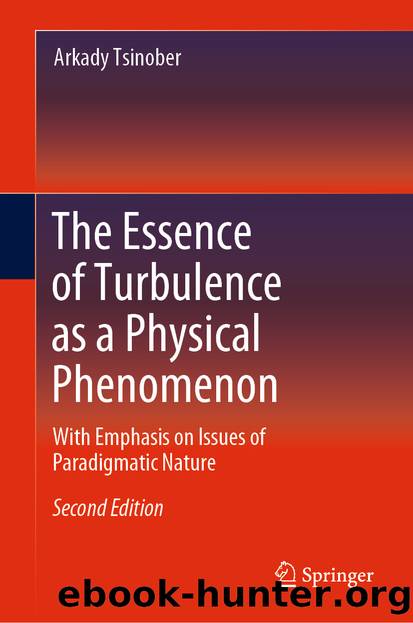The Essence of Turbulence as a Physical Phenomenon by Arkady Tsinober

Author:Arkady Tsinober
Language: eng
Format: epub
ISBN: 9783319995311
Publisher: Springer International Publishing
7.3.4 Direct and Bidirectional Coupling Between Large and Small Scales
Intermittency is an important feature of the common nonlocal life of large and small and scales/structure(s)
By nonlocality is meant (among other things) the direct an bidirectional coupling between large (resolved) and small (unresolved) scales, see Chap. 6 in Tsinober (2009) and below Chap. 9. This generally accepted division of turbulent flows into large and small scales (and similarly into larger number of âregimesâ) is to a large extent artificial and in some sense even unphysical. This is due to the strong coupling between the two and to the multitude of problems/ambiguities defining the term âscaleâ along with the problematic nature of the decomposition approach to the phenomenon of turbulence and the necessity of handling turbulence as a whole in one sense or another. Similarly, the âdecompositionâ in more ârangesâ such as: the injection regime in which the energy injection rate dominates the right hand side of NSE, the energy flow regime in which the flow rates dominate the righthand side of NSE, and the dissipation regime in which the dissipation side of NSE, is to the same degree artificial mainly due to the role of nonlocal effects making such decompositions useless.
Here we concentrate on nonlocality as manifested in direct and bidirectional interaction/coupling between large and small scales. We use the term âcouplingâ rather than âcorrelationâ due to the essential difference between the two which are not synonymous (see Sect. 5.â2 above) as claimed until now, see e.g. Pumir et al. (2016).
There exists massive evidence that the above really is the case as there are many indications that this interaction is bidirectional. We should first mention the well known effective use of fine honeycombs and screens in reducing large scale turbulence in various experimental facilities, Laws and Livesey (1978), Tan-Attichat et al. (1982). The experimentally observed phenomenon of strong drag reduction in turbulent flows of dilute polymer solutions and other drag reducing additives is another example of such a âreacting backâ effect of small scales on the large scales. Further, one can substantially increase the dissipation and the rate of mixing in a turbulent flow by directly exciting the small scales experimentally, e.g. in a jet and in DNS in a periodic box, Suzuki and Nagano (1999), Vukasinovich et al. (2010). Similar effects are observed with small-scale acoustic excitation. Moreover, recent developments in wall bounded shear flows revealed the importance of the interactions of structure(s) in the flow, such as inner-outer interactions including the large-small scales, generally, and with the nearwall region, see e.g. Klewicki (2010), Marusic et al. (2010), Smits et al. (2011), Jimenez (2012), Dogan et al. (2016), Pathikonda and Christensen (2017), Takuya Kawata and Alfredsson (2018).
As one of the premises we would like to point out that vorticity and strain are not just velocity derivatives and not just âsmall scalesâ. They are special for several reasons. As discussed above they reflect the rotational and dissipative nature of turbulence. In the context of nonlocality the property to be stressed here
Download
This site does not store any files on its server. We only index and link to content provided by other sites. Please contact the content providers to delete copyright contents if any and email us, we'll remove relevant links or contents immediately.
The Complete Stick Figure Physics Tutorials by Allen Sarah(7267)
Secrets of Antigravity Propulsion: Tesla, UFOs, and Classified Aerospace Technology by Ph.D. Paul A. Laviolette(5238)
Thing Explainer by Randall Munroe(3850)
The River of Consciousness by Oliver Sacks(3499)
The Order of Time by Carlo Rovelli(3098)
How To by Randall Munroe(2972)
A Brief History of Time by Stephen Hawking(2913)
I Live in the Future & Here's How It Works by Nick Bilton(2901)
The Great Unknown by Marcus du Sautoy(2616)
What If?: Serious Scientific Answers to Absurd Hypothetical Questions by Randall Munroe(2591)
Midnight in Chernobyl by Adam Higginbotham(2434)
Blockchain: Ultimate Step By Step Guide To Understanding Blockchain Technology, Bitcoin Creation, and the future of Money (Novice to Expert) by Keizer Söze(2411)
Networks: An Introduction by Newman Mark(2306)
The Meaning of it All by Richard Feynman(2269)
Easy Electronics by Charles Platt(2253)
The Tao of Physics by Fritjof Capra(2205)
Midnight in Chernobyl: The Untold Story of the World's Greatest Nuclear Disaster by Adam Higginbotham(2128)
When by Daniel H Pink(2058)
Introducing Relativity by Bruce Bassett(2050)
